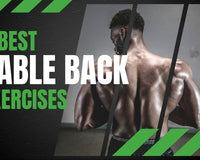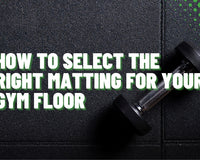Let’s talk about vertical pull exercises. You know, the ones that leave your lats burning, your traps pumped, and your shirts fitting just a little tighter through the shoulders. If you're chasing that coveted V-taper or simply want to add some horsepower to your pull game, vertical pulls are the bread and butter.
These movements work from top to bottom, literally. They're all about pulling resistance down from overhead using your back, arms, and shoulders. And unlike horizontal pulls such as rows, vertical pulls are what give you that wide, winged look.
Let’s get into everything you need to know about vertical pull exercises, why they matter, and how to do them.
What Counts As A Vertical Pull?

A vertical pull involves pulling resistance from above your head downward. It could be your body weight (pull-ups), a cable stack (lat pulldown), or a resistance band attached high on a doorframe.
If the motion is up to down and your elbows are driving past your ribs, you’re doing a vertical pull.
That’s in contrast to horizontal pulls, where you’re pulling something toward your chest in a straight line, usually parallel to the floor.
Related Post: 10 Hip Hinge Exercises
Why Vertical Pulls Matter
Aside from making you look like you’ve got wings tucked under your shirt, vertical pull exercises bring the heat when it comes to real-world strength and injury prevention.
-
They target the lats, the biggest muscle in your back.
-
They build pulling strength that carries over to climbing, swimming, and even opening stubborn jars.
-
They balance out pushing movements like overhead presses, keeping your shoulders healthy.
-
They improve posture by strengthening your upper and mid-back.
Muscles Worked By Vertical Pull Exercises

To really appreciate these movements, it helps to know what you’re working.
Primary Movers
-
Latissimus dorsi (lats): The stars of the show. These run from your spine out to your arms and create that wide, tapered look.
-
Trapezius (traps): Especially the lower and mid sections, which help pull your shoulder blades down and in.
Secondary Muscles
-
Biceps: A key player in any pulling motion. Don’t be surprised if yours are sore after a few sets.
-
Rear delts: These little guys help stabilize your shoulder joint throughout the motion.
-
Rhomboids: Another stabilizer, these muscles help retract the shoulder blades.
-
Core: You’ll engage your abs to stay tight and avoid swinging.
Related Post: 7 Horizontal Pull Exercises
The Top Vertical Pull Exercises You Should Be Doing
Let’s break down the best vertical pull exercises that’ll turn your back from "meh" to “whoa.”
1. Lat Pulldown

This is the classic, and for good reason. If you’re looking to grow your lats, this is where the magic happens.
How to do it
-
Sit at the machine with feet flat, knees secured.
-
Grab the bar with your preferred grip.
-
Pull the bar down toward your upper chest while keeping your chest up and elbows tucked under.
-
Squeeze at the bottom, then return slowly.
Pro Tip: Start each rep with a reverse shrug. Pull your shoulders down before your arms do the work. This activates your lats right from the start.
2. Straight-Arm Pulldown

This one’s like lat pulldown’s sneaky sibling. It isolates the lats and torches them.
How to do it
-
Grab a straight bar attached to a high pulley.
-
Stand tall, lean forward slightly at the hips, and keep your arms straight as you pull the bar down to your thighs.
Pro Tip: Picture driving your pinkies into your pockets. Weird mental image, killer results.
3. Pull-Ups

Ah yes, the gold standard. Equal parts brutal and beautiful. It’s the ultimate vertical pull. You’re moving your entire bodyweight, which builds serious strength and coordination.
How to do it
-
Grab the pull-up bar with a shoulder-width grip or wider.
-
Hang with arms fully extended.
-
Engage your lats and pull your chest toward the bar, then lower slowly.
Pro Tip: Don’t just yank yourself up. Focus on initiating the pull with your lats, not your arms. Elbows down and in.
Related Post: How to Warm Up Before Lifting Weights
4. Single-Arm Cable Pulldown

This unilateral movement is perfect for fixing imbalances and torching your lats one side at a time. It lets you stretch and contract the lat fully, more than you can with both arms working together.
How to do it
-
Use a single-handle attachment on a cable machine.
-
Sit tall, grab the handle, and pull it down to shoulder level with control.
-
Focus on keeping your torso upright and elbow close to your side.
Bonus Benefit: You’ll spot any strength or range differences between sides and correct them.
5. Supinated Pulldown (Chin-Up Grip)
This variation brings your biceps into the mix and changes the lat angle slightly. It gives your biceps a bit more love while still crushing your lats. Win-win.
How to do it
-
Same setup as a lat pulldown, but with an underhand grip about shoulder-width apart.
-
Pull down to your chest, keeping your elbows tight.
6. Neutral Grip Pulldown

Neutral grip means palms facing each other. This variation puts your shoulders in a very natural position and lets you move heavier weight. The neutral grip can be easier on your shoulders and often lets you lift more weight. Heavier reps mean more gains.
How to do it
-
Use a parallel grip bar or V-bar.
-
Pull down smoothly and focus on keeping your chest high and shoulders back.
Related Post: Top 8 Erector Spinae Exercises
Tips For Crushing Your Vertical Pulls
Before you march into the gym ready to rip, here are a few form tweaks and cues that can change everything.
Lead With The Elbows
It’s tempting to think about pulling with your hands. Don’t. Focus on your elbows coming down and back. This shifts tension onto your lats instead of your arms.
Squeeze Those Shoulder Blades
Each rep should end with your scapulae kissing. Okay, maybe not kissing, but at least having a friendly hug.
Control The Eccentric
Don’t just drop the weight. Lower it with intention. That’s where a lot of the muscle-building magic happens.
Mind-Muscle Connection
Studies show that just thinking about the muscle you’re working can increase activation. So yes, daydreaming about your lats during pulldowns is scientifically backed.
When To Use Vertical Pulls In Your Program

Vertical pull exercises fit nicely into any upper-body or pull-focused workout. Here’s a quick plug-and-play format:
-
Upper Body Day: Pair with presses, rows, and core
-
Pull Day: Combine with rows, face pulls, and curls
-
Full Body: Add one or two vertical pulls after squats or deadlifts
Final Thoughts
Vertical pull exercises are your ticket to a wider, stronger, more functional back. They hit all the right muscles, build upper-body strength, and improve performance across the board.
There’s something pretty satisfying about a good set of pull-ups or heavy lat pulldowns. It’s the kind of lift that reminds you why you started in the first place.
So grab that bar, pull with purpose, and let those lats spread like wings.





